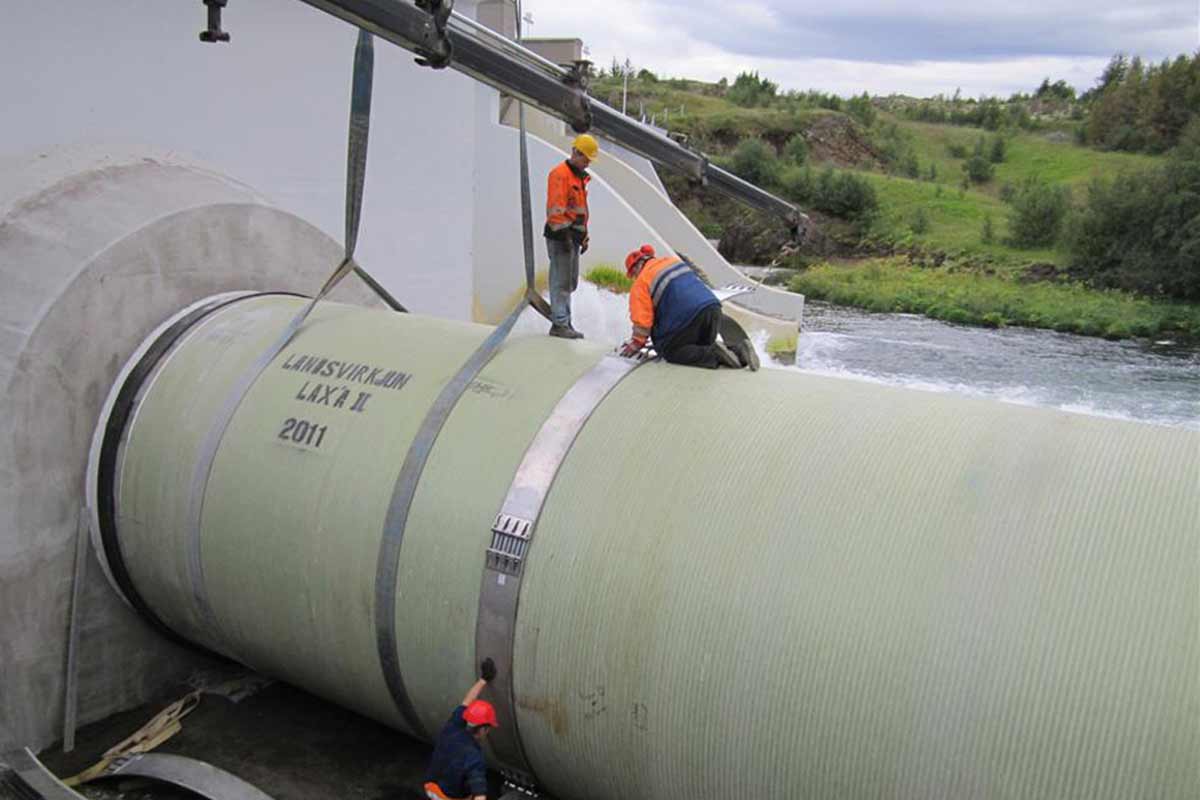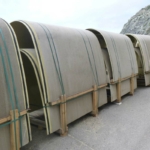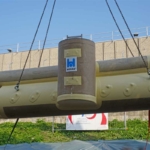
Laxa II Hydropower Plant
Laxá II is a 10 MW hydropower station located in northeast Iceland, approximately 85 kilometres east of the town of Akureyri. The tributary Kráká coming from the highlands of Iceland runs through sandy areas where volcanic sand is blown into the river. The annual amount of sand passing the power station has been estimated to be 10 – 30 thousand tons. The solution for the abrasive water in the Laxá pipe was the application of an additional elastomeric coating material. The coating material was chosen from an extensive development project for high wear resistance pipe liners which has now culminated in Flowtite Orange.
The Laxá Power Plant
Laxá II is a 10 MW hydropower station located in northeast Iceland, approximately 85 kilometres east of the town of Akureyri. Laxá II has been in operation since 1953 and consists of a small dam with a wheel gate from which the water enters a wood stave penstock, 4,0 m in diameter and approximately 350 meters long. A pressure equalising tower is located at the lower end of the wood stave pipe. From the tower the water is conveyed through a steel penstock to the powerhouse with one turbine-generator unit and then back to the Laxá river.
The wood stave penstock has been in operation from the beginning and around 1980 the inside bottom of the wood penstock was concreted to prevent erosion from sand which is considerable in the river. Due to increased maintenance cost and safety reasons, the plan is to replace the wood penstock with a GRP penstock.
Extreme Wear Problems
Sand from the river bed
The tributary Kráká coming from the highlands of Iceland runs through sandy areas where volcanic sand is blown into the river. The annual amount of sand passing the power station has been estimated to be 10 – 30 thousand tons per year (Ref. Laxá Hydropower Scheme report, Multiconsult 2013, LV2013-112). This sand causes severe abrasion issues.
Stones brought with brash ice and melting water
To avoid the brash ice blocking the trash racks, the trash racks are removed from time to time. Large stones can be expected. Stones that fit the gaps between pipe spigots (largest measured gap 27 mm) have been found trapped at pipe joints, larger stones would pass the joints. Stones 50-300 mm can be expected based on video footage.
Flowtite elastomeric liner
Adding elastomerical material
The solution for the abrasion water in the Laxá pipe was the application of an additional elastomeric coating material. The coating material was chosen from an extensive development project for high wear resistance pipe liners which has now culminated in Flowtite Orange.
The elastomeric coating chosen has good erosion and abrasion resistance coupled with good mechanical properties including toughness and elongation. The pipes were first prepared for the coating which was applied with spray equipment in one single pass. The preparation of the pipe ensures good adhesion between pipe and coating. The coating was applied at 2 mm thickness and confirmed by non-destructive thickness measurements.
Improved wear resistance
Inspection of the coatings after one and two years in service noted no significant reduction in thickness with 92-100% of coating still remaining. The ability of the elastomeric coating, and now Flowtite Orange, to provide good wear resistance is well supported from field experience in Laxá.
More information about this application
PROJECT DETAILS
| Project ID: [21802] | |
| Country: | Iceland |
| City: | Husavik |
| Year: | 2011 |
| Application: | Hydropower |
| Installation: | Open Trench |
| Technology: | Flowtite |
| Total Length: | 348 m |
| Nominal Diameter DN: | 4000 mm |
| Nominal Pressure PN: | 10 bar |
| Nominal Stiffness SN: | 5000 N/m2 |
| Client: | Landsvirkjun |


